Real Housewives Creator: Put Ginni Thomas and Mrs. Alito on TV
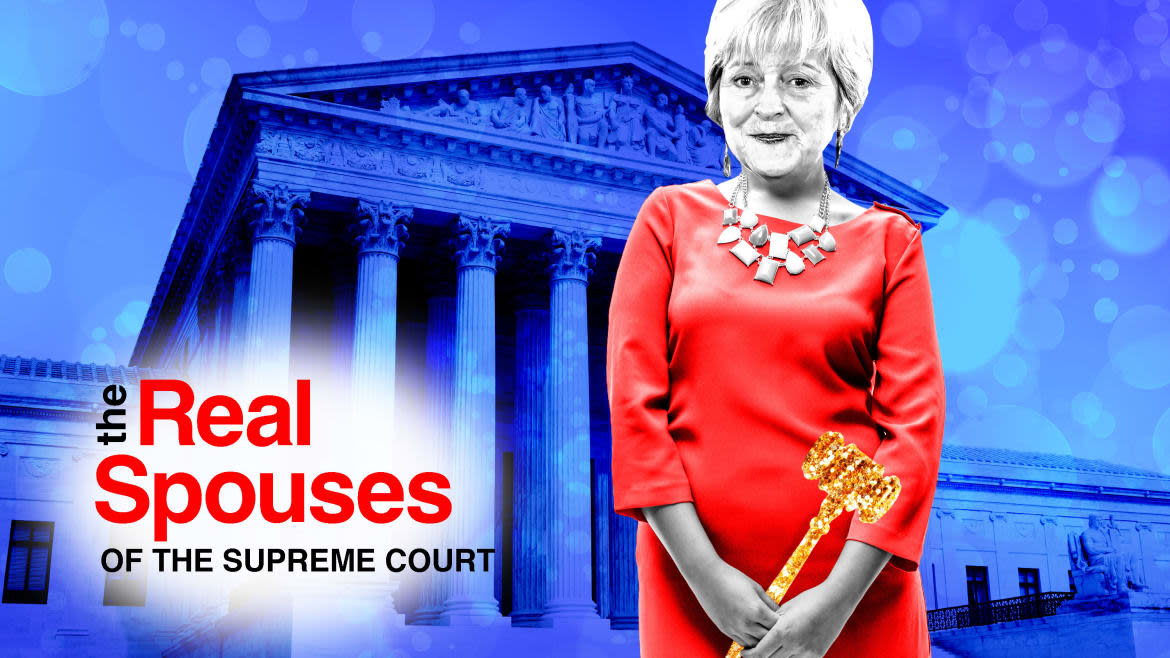
The opening scene might feature Martha-Ann Alito, her eyes burning with fury at the Pride flag fluttering “across the lagoon.” Then, with tinkly musical accompaniment, we see her rummage intensely in a cupboard. Where is it? Dammit, her flag. The flag she wants to raise. Another gleam—righteous vengeance, haha, own those libtards!—flashes in her eyes. We see her go outside, a flagpole standing tantalizingly in front of her. And then the hoisting, hoisting, hoisting—think of Faye Dunaway as Joan Crawford, feverishly wielding the axe in Mommie Dearest—until Martha stands back, task done, the tinkly music at a crescendo.
Wide shot: Martha-Ann Alito has finally raised her own flag— even though her husband, Supreme Court Justice Samuel Alito has asked her to take it down; even though he has also made it publicly clear this flag business is all on Martha, and nothing to do with him. Martha, arms crossed, eyes raised, is now vindicated… aaaand CUT. The first scene of episode one of The Real Spouses of the Supreme Court is in the can.
Scott Dunlop, the original creator of the Real Housewives franchise—Orange County in 2006, its 18th season begins July 11—laughed at Samuel Alito’s ruthless throwing of his wife under the media-outrage bus to save his own skin.
“That’s genius, that’s genius for storytelling! I’d love to do this series,” he told The Daily Beast. “If you really think about it, it is such an isolated, unusual, powerful group of individuals—married and unmarried—that it brings everything into focus within a ‘Housewives’ situation. Here in Orange County, the girls hold an orange in the opening titles. What would the spouses of the Supreme Court Justices be holding? A gavel, some scales of justice?”
Samuel Alito’s Wife, Martha-Ann, Goes Full MAGA in Secret Recording
“I look at Housewives as a brand,” Dunlop told The Daily Beast of the many-stiletto-headed hydra he had created. “I’ve always felt the brand could expand, but in television to de-risk something is tough. You don’t know where it’s going to go.” So, why not the Supreme Court spouses? After all, Martha-Ann Alito’s flag dramas are now entering their third week. On Monday, via a surreptitious recording by liberal activist and documentary filmmaker Lauren Windsor, we heard just how defiant she was in the face of the controversy that has swirled around her.
“There’s a five-year defamation statute of limitations,” Alito said. “Don’t get angry. Get even.” Justice Alito’s efforts to moderate his wife’s flag-flying had also been futile. “He never controls me,” she told Windsor.
However, for now, she apparently isn’t going to go toe-to-toe with the neighboring LGBTQ liberation totem. “I want a Sacred Heart of Jesus flag because I have to look across the lagoon at the Pride flag for the next month,” she said. “I said, ‘When you are free of this nonsense, I’m putting it up.’”
The real-life saga began with the rumbling conflict between neighbors in an affluent suburb of Alexandria, Virginia. Martha-Ann Alito had been in a reportedly long-running and vituperative dispute with her liberal neighbors—a simmering quarrel exacerbated by the flying of an upside-down American flag associated with the “Stop the Steal” campaign. Affluent suburb, squabbling neighbors, powerful people behaving argumentatively and controversially: how perfectly “Real Housewives” it seemed.
It was also revealed that another flag known as “Appeal to Heaven,” associated with the Jan. 6 riot, as well as with a Christian nationalist movement, was flown at the Alitos’ New Jersey beach house.
Then Justice Alito claimed in a letter that it was his wife who was solely responsible for the erection of the flags.
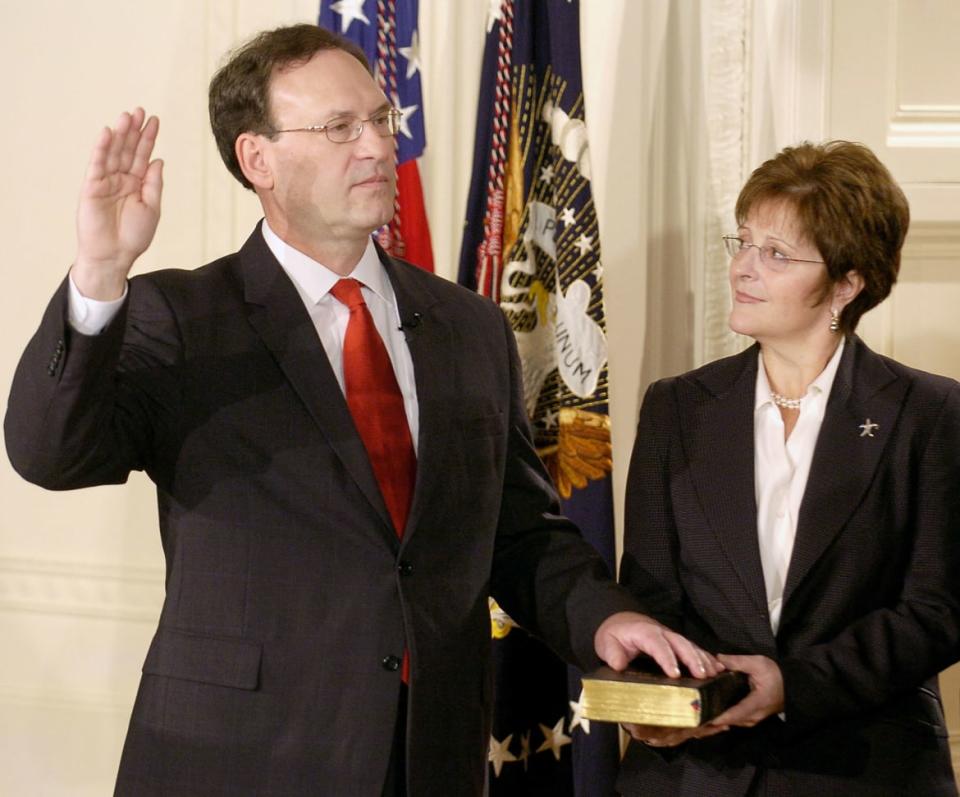
Samuel Alito raises his right hand as he participates in a ceremonial swearing-in in the East Room of the White House in Washington 01 February 2006 as his wife Martha-Ann holds the Bible.
In his bid to ensure he did not have to recuse himself from hearing any Supreme Court cases around those responsible for the violence on Jan 6., Alito very ungallantly sacrificed his spouse—and blamed it all on her: “My wife was solely responsible for having flagpoles put up at our residence and our vacation home and has flown a wide variety of flags over the years.”
As far as the upside-down flag went, “I had nothing whatsoever to do with the flying of that flag,” Alito said. “I was not even aware of the upside-down flag until it was called to my attention. As soon as I saw it, I asked my wife to take it down, but for several days, she refused.”
To make The Real Spouses of the Supreme Court work, “the viewers would have to be privy to what really happens when the male and female Justices come home,” Dunlop told The Daily Beast. “We would show what they’re like at home. We have the anecdotes from the neighbors, we know about all that acrimony. That already fits into the thought that, ‘This feels like an episode of the Real Housewives.’ Is this life imitating art, justice imitating art, who’s imitating art? Or they’re all really pissed off, and they have a right to be.”
Asked what elements of the genre should be built into the Supreme Court franchise, Dunlop listed Schadenfreude, luxury, the conspicuous consumption of food and clothing, living the good life, and travel.
“That can be aspirational—it depends where geographically you’re watching the shows and what your life is like,” Dunlop said of the pleasure of watching the franchise for fans. “The shows are a release for many, aspirational for some, and something they’ll maybe never have, so they can just escape by watching them. I just want it to be entertaining and ironic. I do think irony is becoming more and more revelatory in the Housewives franchise across the spectrum. I always wanted the show to be humorous. I know we’re going to have conflict on the shows, but think we can look at situations that are going to occur and go, ‘Holy cow, he’s bankrupt,’ or ‘He’s going to jail,’ or ‘Really! She did that?’ It’s wild.”
“The cast is already there. It’s up to them”
Should The Real Spouses of the Supreme Court ever make it to our screens, Martha-Ann Alito would not be alone. There is also Ginni Thomas, the Trump-supporting wife of Justice Clarence Thomas, who helped lead the “Stop the Steal” campaign to overturn results of the 2020 election and who attended the Jan. 6 rally, but did not march on the Capitol.
Earlier that day, she reportedly wrote on her Facebook page to those demonstrating, “LOVE MAGA people!!!!” and “GOD BLESS EACH OF YOU STANDING UP or PRAYING.” Later, she apologized to her husband’s former law clerks in a letter: “I owe you all an apology. I have likely imposed on you my lifetime passions.”
Ginni Thomas previously decried Black Lives Matter activists as “radical extremists seeking to foment a cultural revolution because they hate America.”
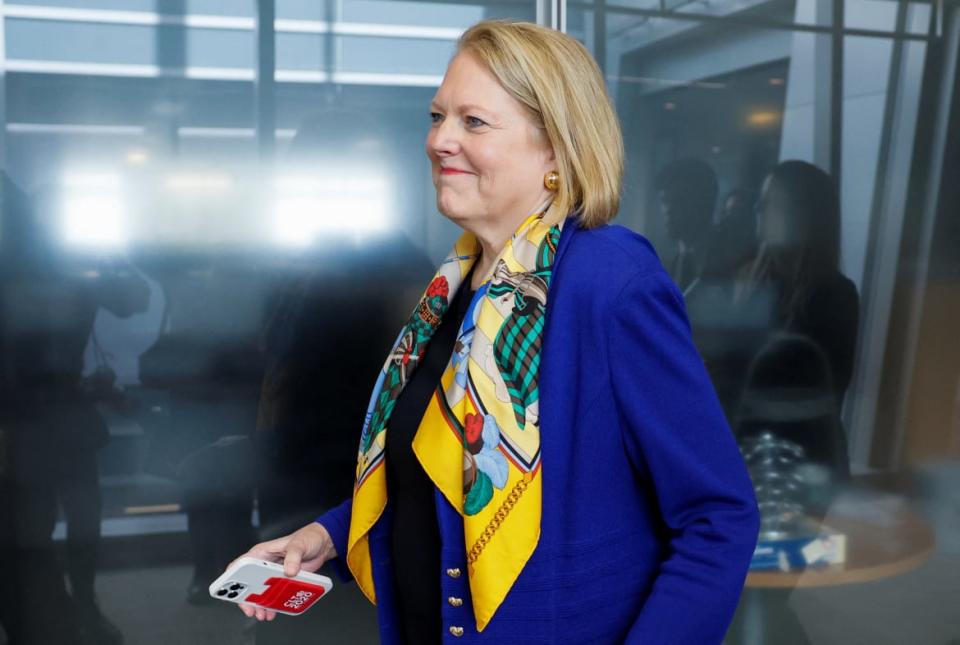
Virginia "Ginni" Thomas, wife of Supreme Court Justice Clarence Thomas, returns to continue her testimony after a break in her closed-door deposition with the House Select Committee to Investigate the Jan. 6 attack on the U.S. Capitol, Sept. 29, 2022.
Thomas’ history of right-wing advocacy is long. As the Washington Post reported, “She has allied with numerous people and groups that have interests before the court, and she has dedicated herself to causes involving some of the most polarizing issues in the country.”
Politico has reported that other Supreme Court spouses’ business practices and interests—and their potential for conflict with cases heard before the Supreme Court—remain mysterious, such as Jesse M. Barrett, husband of Amy Coney Barrett, whose work was described by his legal firm firm as “white-collar criminal defense, internal investigations, and complex commercial litigation.”
Chief Justice John Roberts’ wife, Jane Roberts, Politico reported, is a legal head-hunter. A manager at the firm she previously worked for told Politico they had hired her because “her network is his network and vice versa.”
Justices Sonia Sotomayor and Elena Kagan are both unmarried, but would obviously have honorary positions in the cast making brilliantly cutting remarks about everyone else; they would effectively be the Real Spouses’ Statler and Waldorf.

Scott Dunlop, creator of the Real Housewives of OC, in his home in 2006.
Reality television, Dunlop said, “is about two things—access and casting. If we could get access to the Supreme Court spouses, the cast is already there. It’s up to them.”
Dunlop said he “always” tries to think of ‘Housewives’ from a casting standpoint, embracing diversity as times have evolved, which has been condemned by the right and welcomed by liberals. The polarizing nature of that discussion mirrors so much in the world, he says. He feels “more of the fourth wall is being broken in reality television right now.”
The franchise has become its own cultural phenomenon—and a much-referenced totem in news, entertainment, and politics, which makes a Supreme Court spouses version not-so implausibly fanciful.
Dunlop believes the Housewives’ longevity and influence are down to “a tremendous amount of honesty in producing these shows. Sometimes people will say the shows are scripted, and I tell them they’re not. Obviously, a producer is listening to what is happening in these women’s lives and those things evolve.”
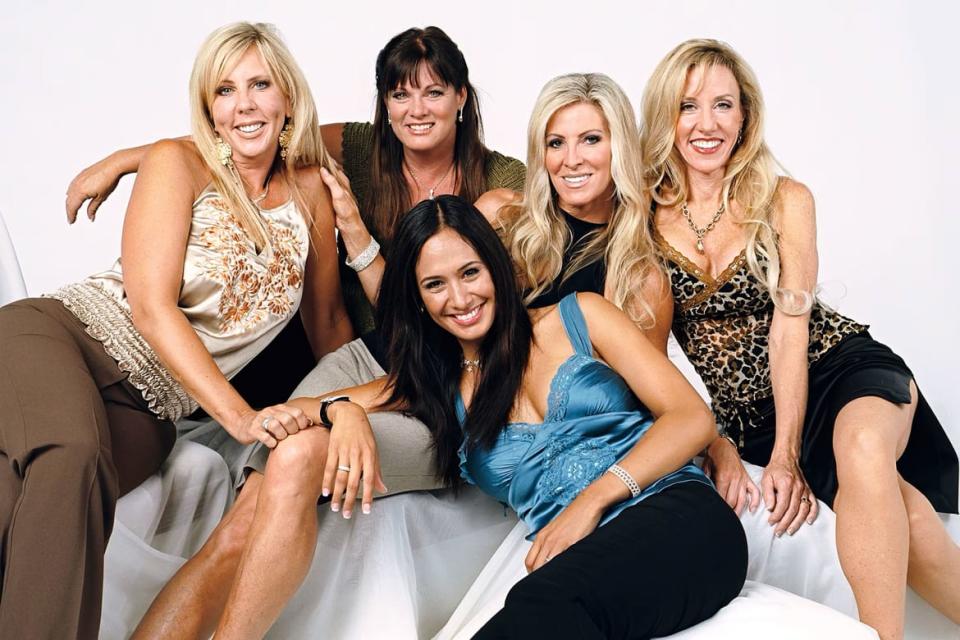
The original cast of The Real Housewives of Orange County.
When he was conjuring up the first “Orange County” iteration of the franchise, Dunlop said it had originally been called Behind the Gates because it was based in a gated community. “I was living in affluent suburbia at the time, and I became kind of bored,” he said.
Initially, in Coto de Caza, the Orange County neighborhood where Dunlop lives, “people were not happy” with his idea, “because they didn’t understand it.”
He said he had always felt like “an outlier” in Orange County, and had gone to a dinner party where “the usual artifice” was in full conversational flow around how he was, how was his wife, what the kids were up to. “We went around the room, and everyone was perfect. We were eating, drinking well, all that nonsense—just like a ‘Housewives’ episode. Someone asked me if I was in bad mood, and I said I was just bored. I said I wanted more authentic responses, and that there was a lot of artifice and hypocrisy that were were part of.”
Dunlop’s friends and neighbors were initially horrified by his idea of filming their lives for a short film until he told them, “Everyone at this table is going to die, so what I am offering you is this little taste of immortality. And then people were interested. That’s how this all started.”
Most of the interviews were with women, rather than men—giving the Housewives its ultimate pulsing heart (even if the New Jersey husbands are arguably as popular as the female leads). “We got lucky, but there were many crazy moments. This community is very conservative. It was extremely white bread and against this. I ended up getting death threats. There was conflict just in the notion of doing it. For me, I just thought, ‘Wow, this is creating a conversation.’ I realized the show would go somewhere—because people either loved it or hated it—but they really couldn’t ignore it. Bravo has done such an amazing job, expanding the franchise even on a global basis. And it just exists and reflects.”
“All I did was come up with the idea,” Dunlop said. “I’ve been entrepreneurial. At the time I was between some things.” Since then, “the network knows where it wants to go.”
At the final pitch meeting, Dunlop said to Bravo’s executives that if it was successful it could replicate geographically. They responded that it would be positive if the show was “still on after six episodes because it was so difficult to launch a show, and for that show to get its legs and stay. Did I have some kind of crystal ball? Well, I had hope. And now I think, ‘When will it go away?’”
The franchise’s impact on pop and wider culture “is because the wives are all very relatable,” Dunlop said. “If you look at the Housewives on an intellectual level you could say it’s ‘cultivation theory’—with people watching it and feeling ‘This is how I live my life’—even though there is conflict because conflict has to move the story forward. We cover a lot of things, and it’s become this cultural ground zero. Whether Supreme Court justices and their spouses watch the show, who knows? We know lot of celebrities do.”
“I’d like to see if Marjorie Taylor Greene is unhinged at home”
The Real Spouses of the Supreme Court would share generic ingredients with the other franchises, and also with the unspoken umbrella genre that powers them all and much else, including our perception and experience of politics: soap opera.
“Absolutely,” said Dunlop. “The Housewives is a bit of social anthropology, and a bit of a docusoap—and soap still sells.”
Dunlop recalled Andy Cohen, then a Bravo executive, calling him during the first season of “Orange County,” and saying, “I just love this show. It’s a ‘village’ show, like Peyton Place.”
“We were fortunate in that first season to have everything occur in one geographical location,” Dunlop said. “Also, what has been reinforced, re-injected, and expanded over the years is Andy being the face of the Housewives, of the brand, of Bravo itself. So you look at those multipliers, and say it still has traction. Are people going to end up not wanting popular culture? I can’t believe that. People are still wanting to go out to dinner, to party, to travel.”
Dunlop finds it “mind-boggling” that the Real Housewives of Orange County has now reached its 18th season, and said that the day of the first episode in 2006 was, fatefully, the same day as the first tweet. “I think all the productions teams of the franchise do a great job. But the accelerant, the gasoline, for the Housewives has been social media. We came in at a time culturally where it was the right show at the right time with the right network with the right target demographically.”
For the few seasons of OC, Dunlop said, the cast stayed fixed, which enabled audiences to form connections with the characters as they would do with any kind of serial television. Originally it was conceived as a “social experiment,” he said—but then the dramas and conflicts became grander and grander.
Initially he had seen the show “as more a hybrid show, like Curb Your Enthusiasm, but Bravo had seen it as fly-on-the-wall, torpedoing one of his early plans to have his friend, the late Paul Reubens, come play golf with the OC Housewives, in his guise as Pee-wee Herman.
Dunlop says he thinks the best Housewives—and this would go for a Supreme Court iteration too—are those who are not too “performative,” which, as a fan, sounds strange and even a little deluded, as over the years the “performances” have gotten ever-wilder and ever-bigger. The audience’s perennial question, Dunlop said, is “Am I entertained?” Answer in the affirmative, the show lives; in the negative, it dies.
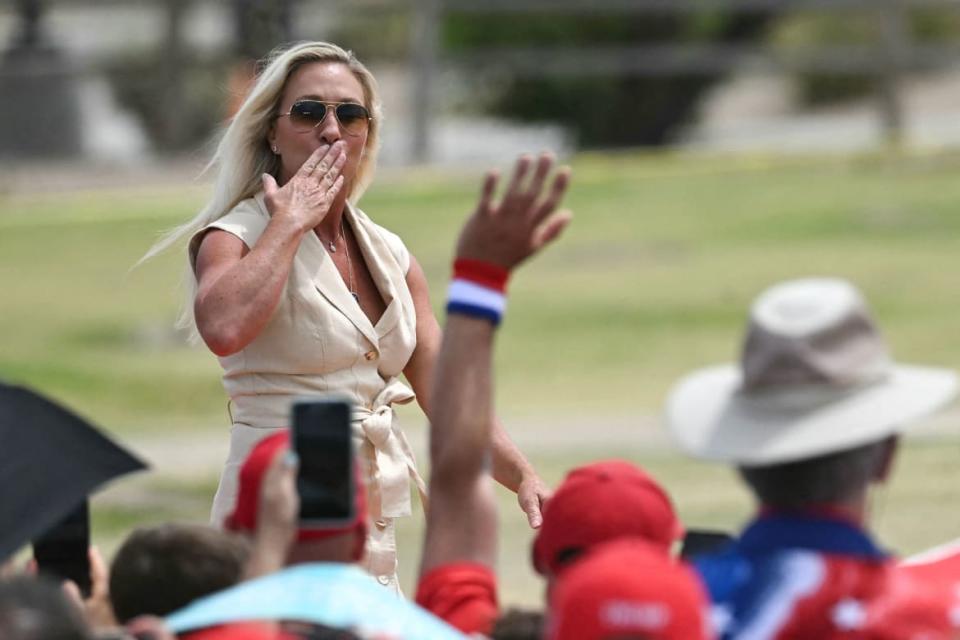
US Representative Marjorie Taylor-Greene, Republican of Georgia, gestures to the crowd as she arrives to speak during a campaign rally for former US President and Republican presidential candidate Donald Trump at Sunset Park in Las Vegas, Nevada on June 9, 2024.
Can Dunlop imagine an end to the franchise? “Gosh, that’s for you to know and me to find out,” he said. “From a practical business standpoint, if the viewership drops the network will make a decision to do whatever it chooses to do. I guess I don’t want it to stop, of course. I don’t know how it would die. Soap operas have been on, they still are, 70, 80-plus years.”
Away from the Supreme Court spouses, what about the wider political establishment (let’s forget the short-lived “DC” chapter)? Dunlop recalled once being asked how politics, and specifically Trump, could be made more entertaining. “My note was I’d like to see him at home in sweats taking the trash out with no make-up, hair not done, hanging out with Melania. I knew that was never going to happen.”
Of today’s political figures who could be Real Housewives, Dunlop said Marjorie Taylor Greene would be a prime candidate. “I’d like to see if she is unhinged at home. Is she relaxed? Is she happy? It would be great to have the Clintons, but they’ve already had their time. I loved the Obamas, but they don’t need this any more. I think there needs to be a new breed of politicians that perhaps would really want to show themselves at home in a structural format of the ‘Housewives,’ but I don’t know if they’re there yet, because I don’t think they really want people to see what’s going down.”
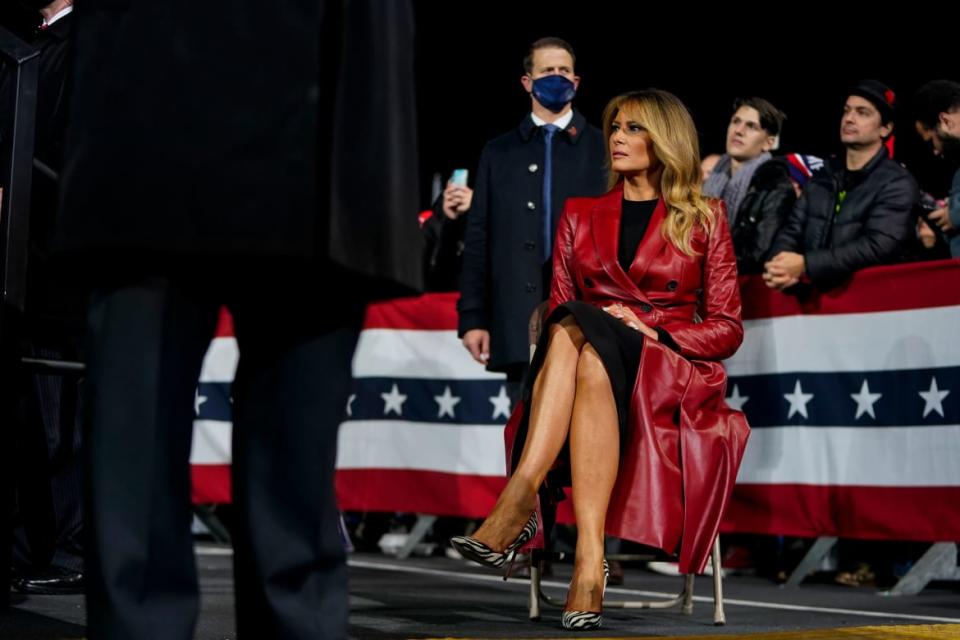
Melania Trump sits off stage as President Donald Trump speaks during a victory rally on Saturday, Dec. 5, 2020 in Valdosta, Georgia.
Is Melania Trump the ultimate missing political Real Housewife?
“Oh, of course she is,” said Dunlop. “I don’t know where she is. I’d love to see if she would talk with us. I’m surprised she hasn’t been on Watch What Happens Live. Do you really think she would be allowed, or would agree? I would hope she has free will. Let’s keep that idea open, and put a check in that box.” Until then, Martha-Ann Alito, Ginni Thomas, Jesse M. Barrett, and Jane Roberts might start practicing proffering their golden gavels.
Get the Daily Beast's biggest scoops and scandals delivered right to your inbox. Sign up now.
Stay informed and gain unlimited access to the Daily Beast's unmatched reporting. Subscribe now.


